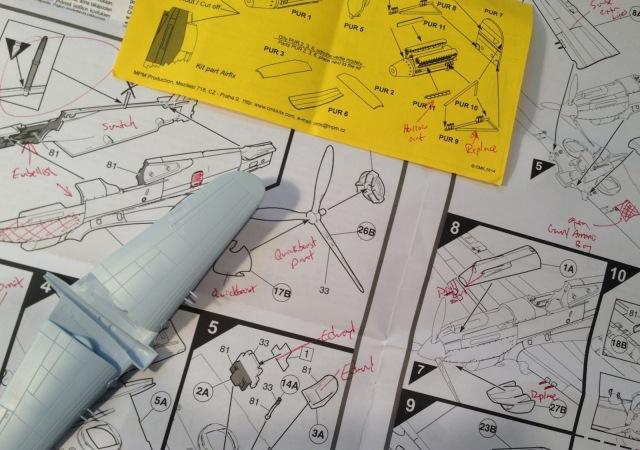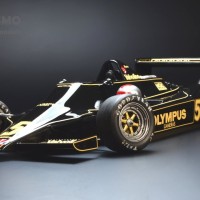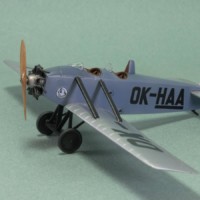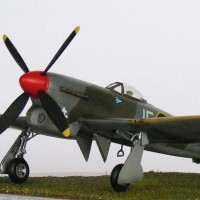The importance of the research phase and build plan.
If you're an old sweat when it comes to modelling, this article is more than likely to be teaching you to suck eggs, and you are probably unlikely to find anything new or helpful within it. However, if you are new or relatively new, you are likely still to be in the development stage of honing your skills and techniques, then this article, with a bit of luck, will impart the importance of the research and planning phase of your builds.
Of course, modelling is subjective art for everyone, if, like me, you are aiming to create an accurate, scale copy of a given subject, then this is a vital skill to help you achieve this. If you are happy to build out of the box, then this will not be such a vital element of your model building, However, this does not mean you will not need it.
I, of course, can only speak for myself when I impart some of the processes I use in researching subject matter, while tips and hints are relatively easy to come by on the internet, the actual build process is individual to the modeller, where one person may build the entire model before painting it, others may paint it as they go and then assemble, and touch up and add weathering and decals as required. As a modeller, you will probably develop your own style without realising you are doing so, simply by what feels right for you, or, as most do, what feels the easiest route to the achieve the end goal.
Instructions
A lot of modellers tend to have a stash, or a “grey army” around the house. usually of kits they have seen when out and about or at modelling fairs, exhibitions etc. and bought with the intent of building. This can be useful, as personally, sometimes, I just feel the need to paint, whether it is to relax, or just simply because I've not painted for a while. A lot of my modelling friends have stashes that number in the hundreds, I personally, prefer only to have a stash of no more than ten to twelve kits at a time (i seem to have broken my own 'rule' since writing this article as its curently 30+), as I find this distracts me from current projects (I currently have 4 unfinsihed kits waiting, as if to prove my own point)
I tend to have a stash of differing models, as I can never predict what I will feel like building at any one given moment, but, each and every one of my kits in my stash, has a build plan already done for it and/or research done before I even think about starting it.
Step 1: Choosing your kit.
A lot of the time, the kits I buy are kits I've seen whilst i have been mooching around a model shop, or browsing ebay/amazon, and i would tend to think that this is probably the norm for most modellers. I do tend to buy most of my kits from ebay though, for two reasons. 1. Its a lot cheaper 2. It allows a period of time before the model even arrives to research and plan the build.
Very rarely will i have a “I know what I fancy building…” moment and actively search for a specific kit/figure, so this is a very personal thing to the modeller.
Step 2: Research
I cannot understate the importance of this if you are planning a detailed, accurate kit. For the benefit of this article, we will assume the model we have bought and are planning to build is Airfix's 1/24th MKIVA P51k Mustang.
When you purchase a kit, often before you've even got the kit home, you will have an idea in your own mind what you want to do with it. I ALWAYS without fail, sit and browse the internet, sometimes for as much as 30-40 hours finding what information I can about the original model that is being depicted. If I cannot find the exact model, I will try to find a picture of a similar one.
What does the Gunsight look like? What colour are the camouflage markings? What does the cockpit look like? what colour is it painted? do I already have this colour or will I need to buy it? Can I mix a colour similar enough to it with the colours I already have? Questions that can only be answered with the proper research and time put in in the first instance.
Whilst searching the internet (how on earth did we cope before it?) I always make a folder, marked with the name of the model, and the scale, and I save any reference pictures I find that will be helpful. These can range from camouflage markings, to close up pictures of engines, cockpits, instrument panels etc. ANYTHING you can find that will help with the accuracy of the model is worth looking at and saving for future reference.
Sometimes though, you will have no idea what you want to do with it UNTIL you start researching it. More often than not, this is the time when ideas develop. I have bought a kit before with a clear idea in mind when buying it, and upon researching it, have found something that made me sit up and say “WOW – THATS SEXY! I'M GUNNA DO THAT” More often than that though, you will probably find yourself conflicted between several different paint schemes/decaling options and its just a case of thinking what you want to do or what would be the most effective to achieve with minimal effort.
If you are converting a kit, as i did with the Spitfire MK Ia Conversion to MK Vb (urgh, my first ever conversion, its not good and its sitting gathering dust in the spare room, and even that is too good for it) then you may find it helpful to find a schematic, or a blue print to look at the differences between the types. As an example, I had to cut the cannon ejection ports on the under wings on the Spitfire, as the MK Ia wasn't fitted with cannons, and I also had to shape the wing blisters for the same reason. Conversion is a difficult, but ultimately rewarding job, but if you don't do your research properly, you may as well just build the kit OOB.
Step 3: The build plan
Again, something which I find absolutely essential to a build, is a clear idea of what you want to do with it once you start. It is a bit pointless starting a kit, only to um and ah as to which of the three versions supplied in the kit you wish to build. This is where the research and the build plan often spill over into each other. Once you have your kit, and you have looked at which version you are going to build, will you be adding after market products such as decals, extra detailing like seatbelts? (Airfix are notorious for leaving these out on their 24th scale aircraft and as such, I always end up buying them) Will you be using a standard paint scheme, or something a little less standard? Is it going to be wheels up, or wheels down? Pilot or no pilot?
I find it easiest to write these ideas down, in scrap form first, then to clarify them by looking at the instructions and write down when and at what point you are going to add any extra details during the build. After all, its no use buying a set of seatbelts, if you then whizz through the kit, and realise you have forgotten to put them in (you may laugh, but I have actually done this more than once before!)
If you have a printer, or access to one, print out some of the pictures you have saved and pin them in the appropriate places to the written build plan, so you can see what you are doing at any one given point during the build. For example, a picture of the cockpit beside the written plan and instructions is going to help you more than having to constantly look away from your build and find the appropriate picture on your PC.
I made the mistake, in my first few builds using a build plan, of putting a time scale on each part of the build. It is entirely up to you whether you do this or not, just be aware that things, more often than not will not run to a time scale, and ultimately, this just may be wasting your time by trying to plan this bit meticulously.
Step 4: The execution
The golden rule of build plans is, once you have a plan you are happy with, STICK TO IT (says he, who has been known to change paint scheme and versions literally moments after putting the primer down) There is no point spending all this time, getting your thoughts organised and ready to go if you flit backwards and forwards between sections that have no natural connection to each other. The easiest way to plan a build is through a natural progression. It is entirely pointless if you start with painting the canopy, then stick the wings together, then build the engine, then paint the instrument panel etc.
Remember also, there is no rush. modelling is not a timed hobby. And although there will undoubtedly be points where you scream “OMG!” and start grasping your hair, the ultimate goal is not to produce the best model in the world, or the most accurate, or the best painted, but to ENJOY IT and have fun and hopefully, to develop your skill so as it leads to further enjoyment.
Step 5: The conclusion
I often find, in order to fine tune future builds, it it easier to write down my thoughts on the build as I go along. This Blog gives me a platform to do so, and also add pictures so I can see how the build is progressing, and analyse how I have done so far, what went wrong, how I can improve for the next build and also, how good the kit was, and whether it is worth buying a kit form the same manufacturer again. Most online blogs are free, this one certainly was, and I thoroughly recommend blogging your builds as a way of not only assessing them, but also recording you progress and advancement as a modeller. It is equally important though, to record you thoughts and impressions of how you felt the build went as a conclusion. This will not only help you to appraise what you feel perhaps you did well, but equally important, will help you appraise what you think you could do better or where you went wrong. This will help you better understand your own strengths and weaknesses as a modeller (mine is decals, I hate them! and yes, we ALL have them no matter how long we have been doing it!)
Remember, there is no such thing as a bad build, because every time you build a kit, you will learn something new, or find a new strength or weakness you can either improve on or develop. I have had builds where the finished item was really shoddy, the paint work was awful, there was glue fingerprints all over the kit etc, but at the end there has always been something that has made me say “hey! the weathering on that is really realistic!” or “I really improved on my decaling technique on that build”.
Reading back through this article, I can see how rigid and meticulous this must seem. Remember, this is a guideline only, as every modeller works differently. Hopefully there will be a few things in here you will be able to find useful, and adapt to the way you work whilst enjoying the hobby, as I did when I was hunting for tips and techniques to help me develop.
I read over on another forum i also joined recently, that "The goal is COMPLETION, not perfection."... Well... Yes, no and also at the same time maybe.
Yes - Because we're all to critical of ourselves.
No - Because we want to do the best we can, and sometimes, this could inspire the opposite.
and Maybe - Because each of us has differing standards of what they consider to be 'perfection'
At the end of the day, as long as we're happy with what we build, and we learn something or take something new from it, then little else matters.
Sláinte!
Tam





Point well taken Tam.
Your philosophy rhymes with mine !
I’m glad to read about having multiple or parallel builds going on. I’m not alone Anymore !
This happens with me when I get to a dead end in painting and figuring out how to get to the next step. This also allows me to apply colors on different models when in the same tone. Often one has to mix paint for a small part that that process becomes long in set up and cleaning spray equipment. With that I keep things moving along. I just started logging what paints I used on what. It took me a bit of time to figure out exactly what I had put on a CF-100 nearing completion. One tip I have is I write the date on each bottle of paint I open with a sharpie. That helps ! Now I log everything in a journal just for that purpose.
Great article . Thank you .
great tip with the sharpie, thanks, will definitely use that. There are more reasons than just the ADMD going on, i often like to finish up one part of a model and then carry on modelling, which means having more kits on the go, for example, this after noons job is to apply the nato green and black to the FV101 Scorpion currently working on, but, when thats done, i dont want to stop, so i'll carry on with say the raptor, the tomcat or the mig29 i have going on. Or hell... i may even finsih the lotus super 7 thats been sat there for years!
I suppose its a bit like having a conveyer belt to enable you to carry on when one job is done and it needs time to dry or cure or whatever.
Thank you. What is ADMD ? The french version is : the right to die with dignity ! Hoping to put some more paint on my “line up “ today !
Good information. That said, at age 84, COMPLETION really IS my primary concern.
I get that totally. Hoping i see many more of your finished builds soon mate
No capability to so.
A nice and true informative write up.As far as what we did without the internet was there were more hobby shops around then are now. A far as stash is concerned, when my father passed on, I had to take care of his stash of about one hundred kits, I ended up donating most to a VA center. To that end my current stash is three, but that's just me.
there are a few forums on facebook where guys share their stashes and there are thousands! i saw one that was literally a garage full, and remember thinking to myself, how are you ever going to find the time to make all those haha
before the internet, the only kits i built were airfix spitfires really, like most boys when they first start, and i can honestly say, research was not a step in my building lol
Airfix was a fix for me too, ala the P-40E, P-39Q, the old Tigermoth and more.
Excellent, and yes a lot of us old hands probably follow a similar formula, but refreshers and reminders are always good, whether correcting your form at the gym, or how you go about a build. Plus I feel this site has quite a few less experienced modelers that can benifit from posts like yours well done! And as for the stash...well I'm at about 50, only 3 have been started and boxed!
I totally agree with regards to the less experienced modellers. Its why i got into sharing things on youtube, and eventually on these types of forums. I feel it vitaly important to try to encourage the next generation as much as possible, or we run the real risk of losing the hobby all together in a generation or two
Good advice throughout.
To paraphrase a famous statement from Vince Lombardi, Research isn't the most important thing - it's the Only Thing!
Every single model I've ever made that didn't "make muster," or model by someone else I have seen that failed, every single one (outside of failures like spilling glue on the canopy) could be cited under Failure To Do Proper Research.
And there is ALWAYS something new to learn, no matter how much of a Subject Matter Expert one believes they are. I'll just mention the latest one, that happened this week. I got a decal sheet from Thundercals for P-47s. Norris Graser does excellent research, so these sheets are top-notch. And in the information section of the instructions, I learned that the "standard" invasion stripe on P-47 wings was not 18 inches as everyone who has read the instructions for painting D-Day stripes ("18 inches for single-engine; 24 inches for multi-engine") knows - they were 20 inches. Except for the ones in some groups that were done around 17-18 inches, so the stripes didn't end up on the ailerons and change the balance. Except they could be 20 inches if the painters started the stripes right next to the fuselage.
Research, and discovering new information like the above, is what makes this hobby fun. And discovering things like the above is always good for someone who pays the bills as an historian, to be reminded that All Things Under Heaven Are NOT Known.
So thanks for this Tam. Your process is a good one.
Aboslutely agree. I did a conversion of a Mk.1 spitfire to a Vb (in what turned out to be a very ill advised move) It was only half way through the build i found out i needed a different spade grip, one with a cannon button on as well, and that the handle on the hatch, was not infact painted red until after the war. Speaking to some of the guys on ww2aircraft.net, who used to work on them, and even fly them in some cases, really hit home how little i knew about the aircraft when i tried the conversion.
Wont be doing that again lol
A very nice and clear description, Tam @fow_models
The last lines you wrote do exactly describe what modelling is about, being satisfied with your own build and being able to learn new techniques or methods.
In the end the best thing is to enjoy watching your own build when it is showing off in the cabinet.
I feel as modellers, its kind of been made necessary to have thicker skins than we should really, all too often the rivet counters are only too happy to cast shade on a build just because youve used the wrong colour of sea grey.
I don't think there is a better advert for Euthenasia than these people.
Loved your article, Tam!
Really great that you took the time to write down all these ideas and advice.
Yes, proper research is of prime importance, as @tcinla also pointed out.
One of the most fascinating aspects of our hobby is researching the subject that is built: amazing details pop up!
Absolutely. as soon as i buy a kit online, io spend hous looking at all the pretty pictures of it. which can, in the case of ww2 german armour, become quite a time consuming activity!
Great info, Tam (@fow_models). I worried about kit selection and research when I used to enter kits in contests, but as I got into my 60s and now 70s (I never thought I would live this long), my priorities have shifted to having fun building and getting kits done. Now I usually decide which model to buy based on a picture of an interesting plane, a distinctive camo, or cool markings. I usually do some research when I am building a model, but I don't do near as much as I used to. I still like reading more about the plane, the pilots, the missions, but I don't get too wrapped up in creating a perfect copy of the original. I will leave that to you young people.
wanna know a secret? whispers i only ever do out of the box builds when im doing a commission, its too boring. currently i have a Scottish air force Mig29 and Yak 130 on the go, and Israeli F22 raptor., OOB is boring, what ifs rule!
Nice one and totally with you on research etc...although sometimes you find the kit offering is so far from reality...😳.
I wasn’t going to have a stash...but it happened 😆. I think in part down to the fact that a lot of decent models seem to be available for a fleeting period...clever of the manufacturers but I am wise to that now🙄.
I don’t tend to parallel build as in the past ( late 80s when I gave up) nothing ever measured up and I tended to just leave them. What I hadn’t the modelling maturity to realise we’d that if we all produced results like me verlinden (that dates it) everyone would do it. Lockdown pushed me into it again and am I thankful ❤️. Ok, not comp winners but I am achieving results I never thought possible and an truly pleased with. Yes, I have problems but rather than bin it I walk away, think, calm down and invariably the problem melts away...there is always a way and every piece of material teaches you something. I have 2 part finished kits that I will finish. One that is just horrible and I don’t have all the answers yet and another that is effectively a full re-scribe and I lost the will to live😆 but otherwise they will all get built eventually. It is amazing what is on the tinterweb if you look though😎.
Great stuff, enjoy your model bashing, never give up👍
3 attached images. Click to enlarge.